Porterhouse vs. T-Bone: Which Is Better?

If you’ve ever found yourself at the butcher’s shop wondering how to tell the difference between the porterhouse vs. T-bone, this guide is for you. These two cuts of steak look incredibly similar on the surface, meaning you’ll have to know a little bit about each before you can judge which one is right for your next meal.
You shouldn’t be worried about telling the difference between these two similar cuts of beef. At the end of the day, knowing the difference between porterhouse and T-bone steaks comes down to knowing the USDA qualifications that separate them.
But whichever you choose, you can be sure that you’re getting a high-quality steak with lots of beef to enjoy. In fact, both porterhouse and T-bone steaks are staples at steak restaurants, simply because they have that classic steak look with the t-shaped bone right in the middle of the beef.
This guide will tell you all about those USDA differences, plus share more about where to buy and how to cook porterhouse vs. T-bone steaks.
Jump to Section
- What Is a Porterhouse Steak?
- What Is a T-Bone Steak?
- Porterhouse vs. T-Bone: What's the Difference?
- Buying Porterhouse and T-Bone Steaks
- Cooking Porterhouse vs. T-Bone
What Is a Porterhouse Steak?
A porterhouse steak is cut from the short loin section of the cow, which runs from the bottom of the ribs through the midsection and to the hip. There is a t-shaped bone that runs through this entire section, dividing the tenderloin filet from the NY strip steak, both of which are popular cuts of beef on their own. Because of these similarities, it can be difficult to distinguish the porterhouse steak vs. T-bone or even the porterhouse vs. ribeye or other cuts of steak.
A porterhouse steak consists of the tenderloin filet, the classic t-shaped bone, and the NY strip steak. It comes from the back of the short loin cut, where the tenderloin muscle is the thickest.
Because it is essentially made of two different cuts and a bone, a porterhouse steak is often quite a large cut of meat, ranging from 24 to 48 ounces. According to the USDA, the tenderloin section of a porterhouse steak must be at least 1.25 inches thick to qualify as this particular cut of meat.
This cut of meat is certainly a well-known one, as many steakhouses use images and videos of this iconic cut to advertise their best dishes. Some restaurants will even present a porterhouse as a meal for two, which gives you another insight into how large porterhouse vs. T-bone steaks are.
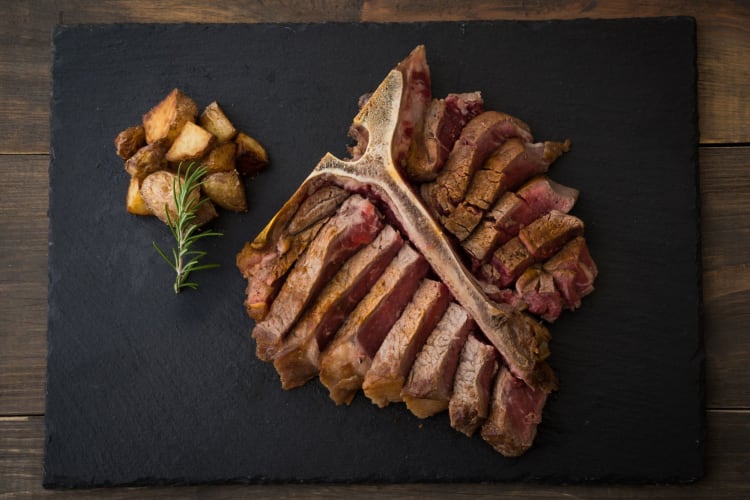
What Is a T-Bone Steak?
Like the porterhouse, a T-Bone steak also comes from the short loin of the cow. The difference is that a T-bone steak comes from the opposite end of the short loin, where the tenderloin muscle is thinner. This means that on a T-bone steak, the tenderloin takes up a smaller portion of the overall steak cut. A T-bone steak still consists of the same three elements — tenderloin filet, t-shaped bone, and NY strip — but the tenderloin filet portion is simply a bit smaller.
The USDA requires that the tenderloin section of a T-bone steak only be .25 inches thick to qualify as this cut of meat, compared to the 1.25 inches required for a porterhouse steak. Because this section is thinner, T-bone steaks often weigh less, ranging anywhere from 16 to 24 ounces overall.
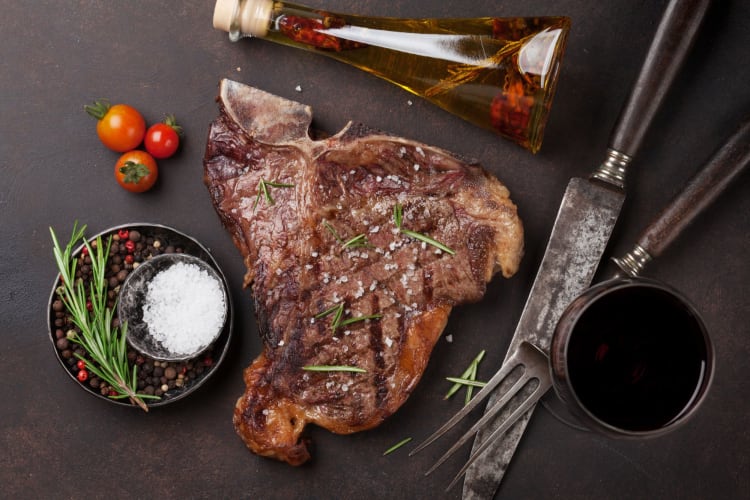
Porterhouse vs. T-Bone: What's the Difference?
Because they contain the same types of meat and the same t-shaped bone, determining the difference between porterhouse and T-bone can be quite difficult. The best way to judge is the size of the tenderloin portion.
In terms of flavor, most steak lovers claim that the porterhouse steak vs. T-bone has more of the tenderloin filet, the entire steak is more tender and perhaps a bit milder. The T-bone, without that large tenderloin portion, tends to have a bit more of a beefy flavor than its near relative, the porterhouse.
Many people claim that a T-bone is a good starting place for those wanting to know the difference without paying for a larger porterhouse steak. You’ll still get both cuts of meat; both will be high quality, but there will be slightly less quantity. This means you’ll have less to eat or fewer leftovers to store.
For those wanting to really dive in, go all out or impress a date at their next steak dinner, the porterhouse might be the better option. It is certainly larger, contains more meat and comes with the price tag to match.
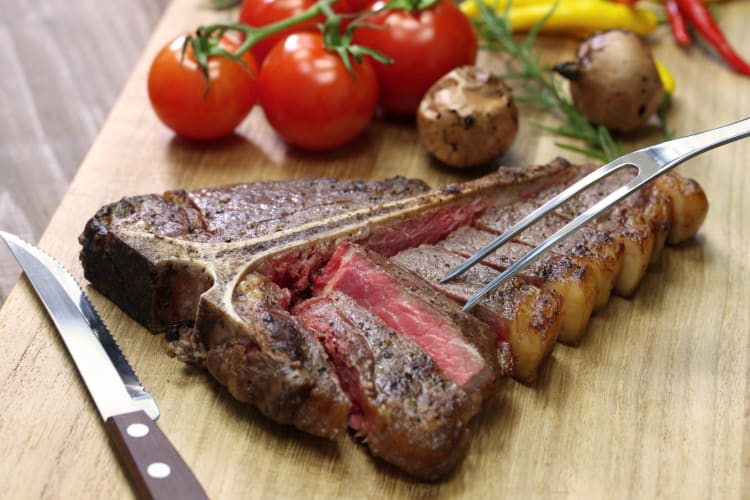
Buying Porterhouse and T-Bone Steaks
When buying porterhouse vs. T-bone steaks for dinner or even as the perfect gift for a steak lover, there are a few things to keep in mind to ensure that you walk away with the most flavorful, highest quality cut of beef.
At the butcher’s shop, be sure that the cut of any porterhouse you purchase has a larger section of NY strip. Be aware that because the porterhouse does have a thicker section of filet than the T-bone, it will often be heavier and pricier. The average price range for a porterhouse steak is anywhere from $18 to $25 per pound.
This price can vary depending on the grade or quality of the beef, as well as the thickness. Because the T-bone steak is smaller and has less of the tenderloin, you’ll find them ranging in price from $10 to $20 per pound.
Another thing to watch out for with a porterhouse is fat marbling. You’ll want to ensure that there’s not too much marbling, as this increases the weight, and therefore the price, of this already top-notch steak.
The good thing to remember if you happen to purchase the wrong steak, you are still getting the same delicious cuts of meat, just in slightly different quantities.
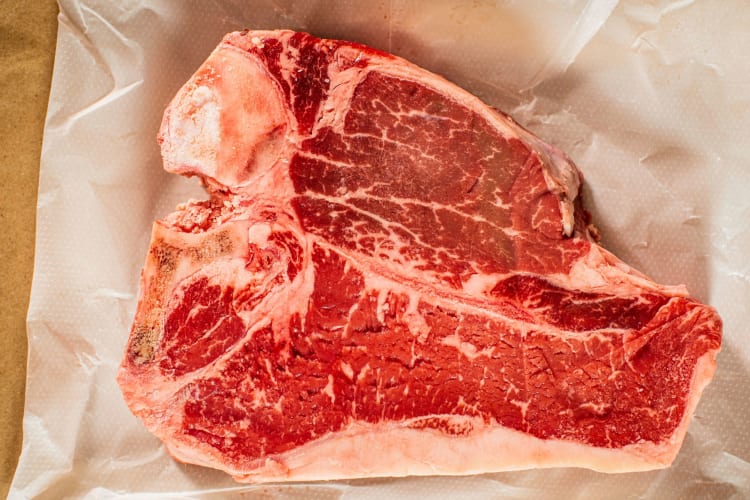
Cooking Porterhouse vs. T-Bone
If you are on a quest to learn how to cook the perfect steak, these two popular cuts of beef are a good place to start. What are the best cooking methods for each type of steak, and how long should you cook them? What should be kept in mind when cooking a porterhouse vs. a T-bone?
To learn professional answers to these questions, it’s always a good idea to consider taking chef-led cooking classes near you or even online cooking classes that can share the best tips and tricks for cooking porterhouse vs. T-bone steaks. Depending on which city you live closest to, you can also find options in NYC, New Orleans and in many other major cities.
Although cooking steak can be fairly straightforward, it is an intimidating task. If you’ve invested a good amount of money in buying either a porterhouse or a T-bone steak, you certainly don’t want to mess it up! A cooking class can show you the perfect ways to grill up, sear or butterfly any cut of beef you bring home from your next trip to the butcher’s shop.
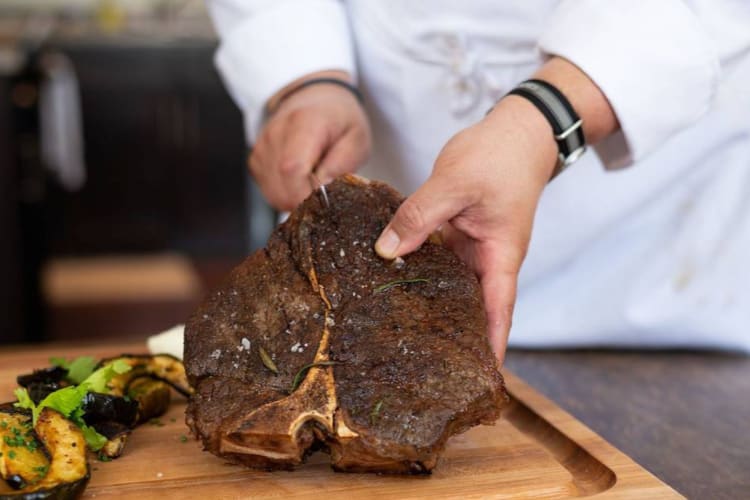
Cooking Methods
If you are looking for quick answers in the meantime, we’ve still got you covered. There are multiple ways to prepare any cut of beef, and porterhouse and T-bone steaks are no exceptions. The most common way is to grill your steak after first prepping it with a salt and pepper rub or your favorite steak rub.
When grilling these steaks, it’s important to remember that they both include two different types of beef. This means that each side (the tenderloin and the NY strip) will need slightly different cooking times and temperatures to taste best.
The tenderloin side will cook quickest, so be sure that if you are grilling your steak you place that side of the steak on the cooler side of your grill. The strip side of a porterhouse and T-bone will cook more slowly, so it can take more heat than the tenderloin.
What should you do if grilling out isn’t a possibility, or if you simply prefer to cook indoors? There are certainly still cooking options available for you, whether you choose a porterhouse or a T-bone. You can also pan-sear both of these cuts of beef. For this method, sear your porterhouse steak for around 3-4 minutes per side on the stovetop before finishing it off in the oven for anywhere from 5-20 minutes based on your preferred level of doneness.
For a T-bone, use the same approximate timings, always being sure that your steak reaches a safe temperature of at least 120 degrees Fahrenheit for medium-rare. Remember that because the T-bone is often the smaller cut, it will generally cook a little bit quicker. Be sure you keep an eye on it to avoid overcooking.
With both the porterhouse and the T-bone, you’ll want to let the meat rest after cooking. Then, for the best results, cut the two halves of the steak away from the bone and slice them both across the grain.
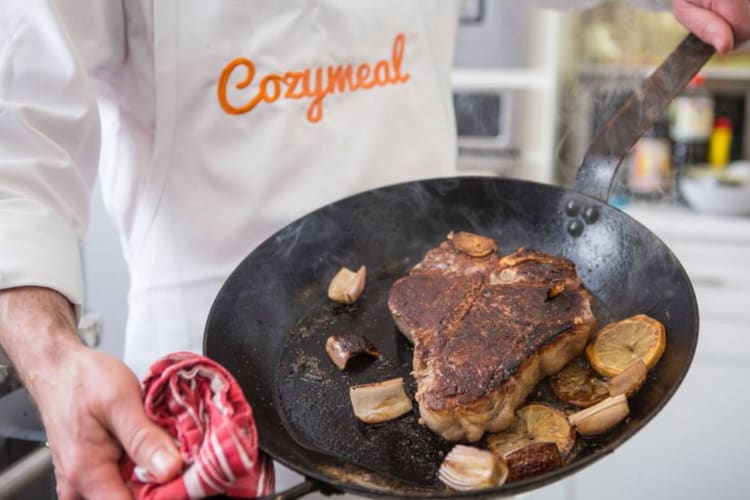
Side Dishes and Sauces
Anyone who’s enjoyed a classic steakhouse dinner has probably seen both the porterhouse and T-bone paired with some version of a potato, whether baked, mashed or fried. While this is a classic combination, there are other great side options available.
Try roasted beets and carrots or green beans almondine to create a contrast between the robust beefiness of your steak and the flavors of the vegetables. Serve your porterhouse with a homemade steak sauce to add more flavor to this cut of beef. If you’re serving a T-bone, try something with a sweeter side to it, like a cranberry-flavored sauce that adds a little bit of a fruity kick to the heartiness of your steak.
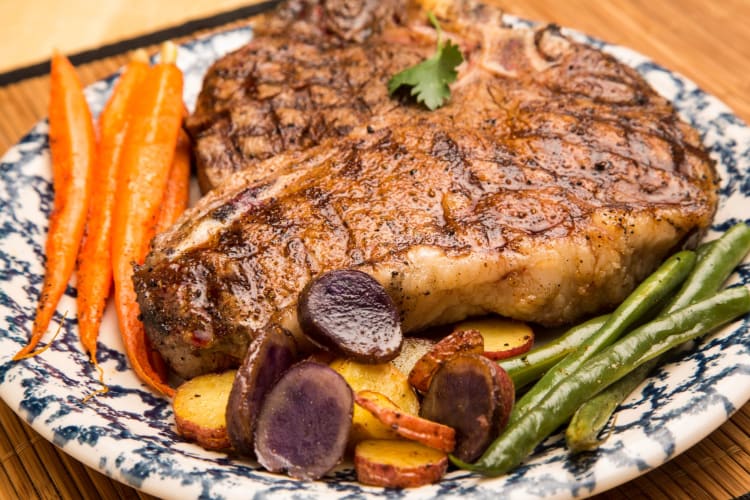
We hope this guide to the differences between the porterhouse vs. T-bone steak has helped you know which cut of beef is best for your next event or meal on the town.
Though they look very similar, the key to telling them apart is to look at the size of the tenderloin portion on each. The porterhouse will weigh in with a larger tenderloin and overall larger weight.
For even more ways to explore your favorite foods, check out other experiences happening on Cozymeal.



FOOD FOR THOUGHT?
Join the conversation.